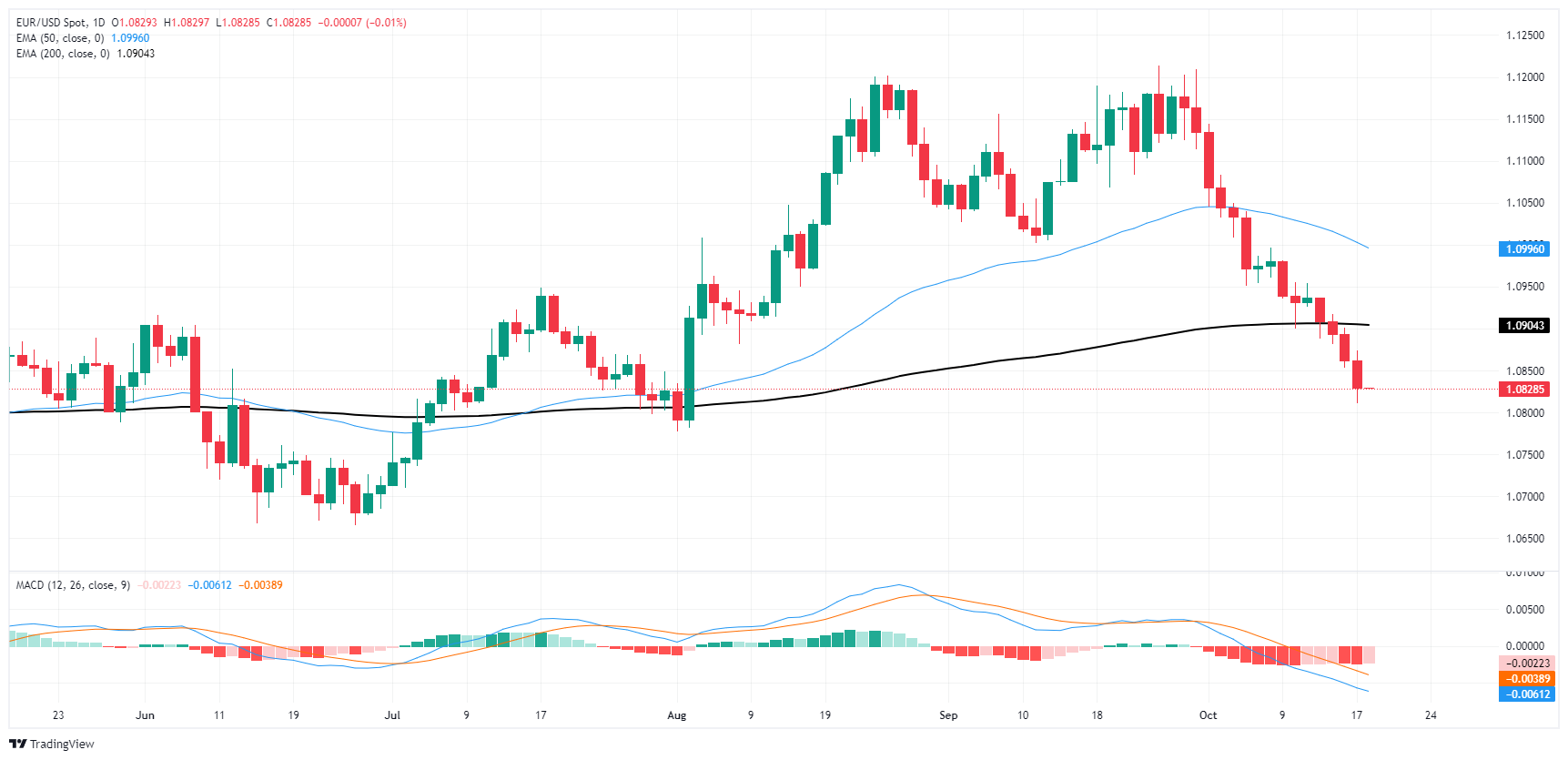EUR/USD continues to slump after ECB rate cut
- EUR/USD lost another one-third of one percent on Thursday.
- The ECB cut rates in-line with expectations, stripping support from underneath the Euro.
- US data blew the doors off market forecasts, further bolstering the Greenback.
EUR/USD continues to backslide following the European Central Bank’s (ECB) quarter-point rate trim early Thursday. A lack of bullish momentum has Fiber extending near-term losses, and the pair is down over 3.5% from late September’s peak bids just above 1.1200.
The ECB trimmed its reference rates exactly in-line with median market forecasts, delivering a 25 bps cut to its Rate on Deposit Facility and Main Refinancing Operations Rate, easing the reference rates to 3.25% and 3.4%, respectively. As if the Euro didn’t have enough support as it is, Europe’s final Harmonized Index of Consumer Prices (HICP) inflation for the year ended September also declined more than expected, with the final print coming in at just 1.7% YoY compared to the expected 1.8%.
All that remains on the EU-centric economic data docket is Friday’s upcoming EU Leadership Summit, but the event is unlikely to spark much confidence in the Euro as policymakers grapple with a lopsided economy tilting toward a steeper slowdown despite insistence from leaders that it isn’t.
US Retail Sales grew by 0.4% MoM in September, recovering from August’s 0.1% and beating median market forecasts of a 0.3% print. Retail Sales excluding Automotive spending also thumped forecasts, growing by 0.5% in September compared to the expected 0.1%, and easily vaulting over August’s 0.2% increase.
US Initial Jobless Claims for the week ended October 11 also beat market expectations, coming in at 241K for the week. Investors expected the week’s new jobless claimant count to hold steady at the previous week’s revised 260K.
EUR/USD price forecast
EUR/USD has experienced significant bearish pressure, breaking below both the 50-day Exponential Moving Average (EMA) at 1.0996 and the 200-day EMA at 1.0904, marking a clear bearish shift in market sentiment. The pair is now trading near 1.0828, testing multi-week lows as the downside momentum intensifies. A sustained break below 1.0800 could lead to further declines, with the next major support area around 1.0750. The sharp decline in recent sessions reflects the growing strength of the bearish trend, with sellers maintaining control as the pair moves away from key moving averages.
The Moving Average Convergence Divergence (MACD) indicator is deeply entrenched in negative territory, with both the MACD and signal lines showing no signs of reversal, suggesting that bearish momentum could continue. The histogram is expanding further into the negative, indicating an acceleration of the downside movement. If the pair fails to hold the 1.0800 support level, we could see additional losses, with 1.0750 and possibly 1.0700 on the horizon. On the flip side, a recovery above 1.0900, where the 200-day EMA lies, is needed to diminish the bearish outlook and bring some relief to the bulls.
EUR/USD daily chart
Euro FAQs
The Euro is the currency for the 19 European Union countries that belong to the Eurozone. It is the second most heavily traded currency in the world behind the US Dollar. In 2022, it accounted for 31% of all foreign exchange transactions, with an average daily turnover of over $2.2 trillion a day. EUR/USD is the most heavily traded currency pair in the world, accounting for an estimated 30% off all transactions, followed by EUR/JPY (4%), EUR/GBP (3%) and EUR/AUD (2%).
The European Central Bank (ECB) in Frankfurt, Germany, is the reserve bank for the Eurozone. The ECB sets interest rates and manages monetary policy. The ECB’s primary mandate is to maintain price stability, which means either controlling inflation or stimulating growth. Its primary tool is the raising or lowering of interest rates. Relatively high interest rates – or the expectation of higher rates – will usually benefit the Euro and vice versa. The ECB Governing Council makes monetary policy decisions at meetings held eight times a year. Decisions are made by heads of the Eurozone national banks and six permanent members, including the President of the ECB, Christine Lagarde.
Eurozone inflation data, measured by the Harmonized Index of Consumer Prices (HICP), is an important econometric for the Euro. If inflation rises more than expected, especially if above the ECB’s 2% target, it obliges the ECB to raise interest rates to bring it back under control. Relatively high interest rates compared to its counterparts will usually benefit the Euro, as it makes the region more attractive as a place for global investors to park their money.
Data releases gauge the health of the economy and can impact on the Euro. Indicators such as GDP, Manufacturing and Services PMIs, employment, and consumer sentiment surveys can all influence the direction of the single currency. A strong economy is good for the Euro. Not only does it attract more foreign investment but it may encourage the ECB to put up interest rates, which will directly strengthen the Euro. Otherwise, if economic data is weak, the Euro is likely to fall. Economic data for the four largest economies in the euro area (Germany, France, Italy and Spain) are especially significant, as they account for 75% of the Eurozone’s economy.
Another significant data release for the Euro is the Trade Balance. This indicator measures the difference between what a country earns from its exports and what it spends on imports over a given period. If a country produces highly sought after exports then its currency will gain in value purely from the extra demand created from foreign buyers seeking to purchase these goods. Therefore, a positive net Trade Balance strengthens a currency and vice versa for a negative balance.
